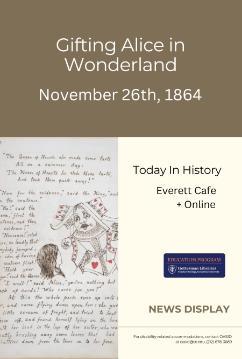Today In History: Gifting Alice in Wonderland

There was a table set out under a tree in front of the house, and the March Hare and the Hatter were having tea at it: a Dormouse was sitting between them, fast asleep, and the other two were using it as a cushion, resting their elbows on it, and talking over its head. "Very uncomfortable for the Dormouse," thought Alice, "only as it's asleep, I suppose it doesn't mind."
The table was a large one, but the three of them were all crowded at one corner of it. "No room! No room!" they cried out when they saw Alice coming.
"There's plenty of room!" said Alice indignantly, as she sat down in a large arm-chair at one end of the table.
-- Lewis Carroll, Alice in Wonderland, Ch. 7, "A Mad Tea-Party", p.54.
On November 26th, 1864, Charles Lutwidge Dodgson, better known by his pen name Lewis Carrol, gave an early Christmas present to a family friend, twelve-year old Alice Liddell; it was a handwritten and pen-and-ink illustrated manuscript entitled "Alice's Adventures Under Ground." On a summer's boat trip with Alice and her sisters two years prior, he told them an imaginative, non-sensical story of a young and curious girl named Alice who fell down a rabbit hole, only to encounter a series of intriguing adventures with whimsical, often difficult and annoying anthropomorphic characters, including a Mad Hatter, March Hare, White Rabbit, Cheshire Cat, Hookah-Smoking Caterpillar, and many more. Then 10-year old Alice Liddell persuaded the brilliant Oxford mathematician, son of a country parson, to write it all down, and the English novelist Henry Kingsley, who spotted the manuscript at the Liddell family home, recommended its publication. The sequel to Alice's Adventures in Wonderland (MacMillan, 1965) would then follow as Through the Looking Glass (MacMillan, 1871).
Commonly known as Alice's Adventures in Wonderland, Carroll's masterwork is cherished and read all over the world to this day, also with great fondness for the timeless illustrations by artist John Tenniel, a humorist and political cartoonist. This classic children's book of literary nonsense is interpreted by some as a criticism of the Victorian era that reflects changing visions of childhood and the difficulty of growing up in a time of rigid social structures, norms, and expectations. The absurdity of Alice's experiences in an illogical fantasy world has been captured in many forms, including Broadway stage and Disney movie.
The following articles are drawn from Proquest Historical Newspapers, which informs and inspires classroom teaching and learning.
- Poore, C.G. 1928, Mar 25). "Alice in Wonderland" Meets New Adventure: Lewis Carroll's Manuscript, Prepared for a Real Alice , Is to Be Put Up at Action in London -- How Wonderland Came to Be Discovered. New York Times (1923-)
- Centenary of Lewis Carroll: 1832-1898: His Life and His Books. (1932, Jan 27). The Manchester Guardian (1901-1959)
- "Alice in Wonderland" Reported Dying: Alice of "Alice in Wonderland" Battles Death. (1934, Nov 04). Chicago Daily Tribune (1923-1963)
- Wireless to The New York Times. (1934, Nov 17). Alice Hargreaves Is Dead in England: Inspired "Alice in Wonderland" Which Lewis Carroll Told to Her and Sisters in 1862. Long Held Manuscript Parted with It at Auction. In 1928 Guest of Columbia. New York Times (1923-)
- Manuscript of "Alice in Wonderland": American Gift to Britain. (1948, May 06). The Manchester Guardian (1901-1959)
- Auden, W.H. (1954, Feb 28). The Man Who Wrote 'Alice'. New York Times (1923-)
- Spiegelman, J. (1964, Dec 15). Century-Old 'Wonderland' for an Alice. The Christian Science Monitor (1908-)
- Cooper, K. J. (1991, Aug 11). Children's Literature Not Just Kids' Stuff. Boston Globe (1960-)
- Wondering at Alice. (1995, Dec 24). The Times of India (1861-)
- Lovett, C. (2015, Nov 15). Finding Alice's 'Wonderland' in Oxford: Exploring the Setting for the Tale of a Little Girl Who Fell Down a Rabbit Hole and Had a Wonderful Adventure in Its 150th Year. New York Times (1923-)

Tips:
- Carroll, Lewis. Alice’s Adventures Under Ground : Facsimile of the Author’s Manuscript Book with Additional Material from the Facsimile Edition of 1886. New York: Dover Publications, 1996. Closed Stacks Juvenile ; PZ8.D666 Al27.
- Caroll, Lewis. Alice's Adventures Under Ground. 1864. Internet Archive (facsimile, via British Library Virtual Books).
- Carroll, Lewis, and John Tenniel. Alice’s Adventures in Wonderland. New York: Books of Wonder, 1992. Curriculum ; PZ7.D684 Ai 1992.
- Carroll, Lewis et al. The Annotated Alice : Alice’s Adventures in Wonderland and Through the Looking Glass. New York: Wings Books, 1993. Closed Stacks Juvenile ; PZ8.D666 Ap 1960.
- Carroll, Lewis, and Francine F Abeles. The Mathematical Pamphlets of Charles Lutwidge Dodgson and Related Pieces. New York: Lewis Carroll Society of North America, 1994. Stacks ; QA3 .C295 1994.
- Jaques, Zoe, and Eugene Giddens. Lewis Carroll’s Alice’s Adventures in Wonderland and Through the Looking Glass : A Publishing History. 1st ed. London ; Routledge, 2016. e-book.
- Reichertz, Ronald. The Making of the Alice Books : Lewis Carroll’s Uses of Earlier Children’s Literature. 1st ed. Montreal: McGill-Queen’s University Press, 1997. e-book.
- Susina, Jan. The Place of Lewis Carroll in Children’s Literature. 1st ed. New York: Routledge, 2010. e-book.
Images:
- Illustration from The Nursery "Alice", "Alice's Adventures in Wonderland" (1890) illustrated by John Tenniel. Courtesy of Rawpixel.
- Poster Image: The Queen of Hearts, from "Alice's Adventures Under Ground", p. 88. Courtesy of Internet Archive.

